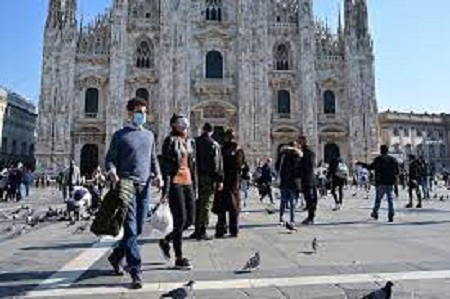Italy – For information on admission requirements to Italy, see the website of the Italian Ministry of Foreign Affairs. The Italian Ministry of Health has barred admission into Italy from a number of southern African nations as of November 26th owing to the Omicron COVID-19 strain.
Depending on where you are travelling from, you may be needed to produce a negative COVID-19 test (PCR or antigen) 48 to 72 hours before arrival, as well as a COVID-19 test at the conclusion of self-isolation if necessary. The Italian government categorises admission restrictions for countries of origin based on COVID-19 risk. To discover the entrance procedures and any COVID-19 test and self-isolation requirements influencing your journey, visit the Italian Ministry of Foreign Affairs website and use the English-language interactive tool and other information.
If you have been in or transited through particular countries in the 14 days preceding your arrival in Italy, you must self-isolate. You are not permitted to enter if you have stayed or transited through a small number of the specified countries in the 14 days preceding your arrival. See the Italian Ministry of Health website for a list of individual nations, and utilise the interactive tool on the Italian Ministry of Foreign Affairs website.
You should fill out a digital passenger locator form before travelling to Italy. If you are unable to access and complete the online form, you must submit a physical copy self-declaration form declaring:
you are aware of the Italian health measures for COVID-19 where you have been in the previous 14 days – you may need to self-isolate for up to 10 days depending on where you are travelling from you have not recently tested positive for COVID-19
your point of departure your reason for visiting Italy
your contact information
Whether you need to take a COVID-19 exam upon arrival, check with your airline or the airport to see if testing facilities are available. If you are travelling to an airport that does not have a testing facility (or if the facility is closed when you arrive), you must self-isolate and take a test at another facility within 48 hours of your arrival. To arrange this, phone the COVID-19 hotline (Italian only) for the region you’re in. If you do not meet this condition, you may be penalised.
Certain rules enable foreign buyers and exhibitors to enter Italy for the purpose of participating in international trade fairs with reduced quarantine requirements following testing. On the needed process, Italian authorities collaborate with fair organisations. If you believe this applies to you, you can get more information from the fair organisers or the Italian Embassy in Australia.
There are no exit restrictions in Italy.
However, certain nations may impose entrance restrictions on Italian visitors. The regulations of entry and transit are subject to change at any time. Read the travel advice for each of your destinations (including transit) and verify with the country’s embassy or consulate. Before you go, check with your airline or travel provider for the most up-to-date information on entry and transit restrictions.
Under the EU Digital Certificate Scheme, Italy offers COVID-19 vaccination certificates and recognises COVID-19 vaccination certificates produced by other EU member states.
A Green Pass is necessary to enter and exit numerous public locations, including but not limited to indoor sitting in bars and restaurants, museums, exhibits, swimming pools, fairs, and big events, as well as to move in and out of’red’ or ‘orange’ zones.
A Green Pass, or a similar credential recognised by Italian authorities, is also necessary to board most regional trains, ferries, and buses.
Choosing to stay in Italy
If you test positive for COVID-19 in Italy, you may be kept in a quarantine facility until two consecutive negative tests are documented. Local authorities may advise you to isolate yourself at home or in your place of residence. This can be a time-consuming operation.
The Italian government recommends that all visitors to Italy download the Immuni Software, a non-mandatory contact tracing app that helps health professionals swiftly identify and contact persons who may have been exposed to COVID-19. More information about the measures may be found on the Ministry of Health’s website (in English).
Due to the possibility of local transmission of COVID-19, there are safeguards in place throughout Italy. A color-coded categorization system is in place to signify the various levels of danger, as well as the various precautions in place across areas, such as whether stores and restaurants are open or whether you may travel across zones.
Each of the country’s 20 areas is classified as red (high danger), orange (medium risk), yellow (low risk), or white (lowest risk). The Italian government is always evaluating the situation and reserves the right to change regional categories at any time. The Ministry of Health’s website has information on the regional risk colour categories. The website of the Ministry of Health also offers information on the limits and regulations that apply to each colour zone.
There are presently no limitations on travel between the yellow and/or white zones. Inter-regional travel involving red or orange zones will be restricted to individuals with a ‘green certificate’ (Green Pass). The certificate will be valid for up to six months if you have been vaccinated or recovered from COVID-19. A 48-hour certificate can be provided if you produce a negative COVID-19 test result. The Ministry of Health’s website has further information about the green certificate.
Curfews do not apply in areas classified as ‘white’ risk. If a zone is labeled’red,’ ‘orange,’ or ‘yellow,’ you must abide by any curfew restrictions imposed by local authorities (for additional information, check the interactive map). You may only leave the house during the curfew if you have a solid cause; this might be a confirmed work need, health reasons, returning home, or any other case of need or urgency. If you are out after curfew, you must fill out a computerised passenger locating form or a self-declaration form. Make careful to heed the recommendations of local authorities.
Outdoors, masks are not necessary in ‘white’ zones. However, you must keep a mask with you for usage when distancing is not feasible, such as in big crowds or inside. Masks must be worn in all public venues, inside and outdoors, in higher risk regions, in accordance with rules. This measure is in effect 24 hours a day, seven days a week. Exceptions include outdoor athletic activities, children under the age of six, and those with medical issues that prevent them from wearing masks. In all parts of Italy, you should pay special attention to signs.
Some venues may need you to go through particular procedures before entering, such as a temperature check, registration of contact information, and the usage of gloves and a mask.

















